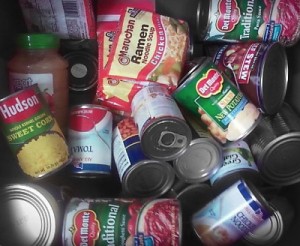Guest Blog Post via the Center for a Livable Future (CLF) at Johns Hopkins University
By Jennifer Hartle, Postdoctoral Research Fellow, Stanford University
Each day, as I drop my daughter off at her pre-school, I am horrified to see the canned food drive bin in the threshold.
It is not that the bin itself is scary to me—although it is dressed up as a six-foot tall Thanksgiving turkey that says, “Feed me.” It is not all of the sodium and industrial ag products packed tightly in the can that’s upsetting me. What concerns me most, as a doctoral student researching environmental contaminants in the food system, is all of the BPA that has leached from those epoxy resin can linings into the food. I read report after report confirming that, although we have a dearth of human epidemiological evidence on the health effects of BPA, we certainly have animal data that find BPA to be linked to many adverse health effects including endocrine disruption and carcinogenesis.
I fully embrace the spirit that we are trying to instill in our children that those who are fortunate enough to have food on our table everyday should give to those in need. What I wrestle with in this situation, though is, Is it okay that we are feeding food-insecure people with consumables that we would not put on our own tables? Many would ask (or argue): If the alternative to eating canned food is no food at all, then how dare I advocate the reduction in canned food to feed the hungry? Well, I don’t think that the issue is canned food or no food. Food insecurity is a much more complex topic than that.
One idea I have comes from what I remember from one of my field trips to the Maryland Food Bank during my Baltimore Food Systems class. (Thank you, Roni and Anne!) What one of the employees at the Maryland Food Bank told us was that it was much more helpful (in terms of both resources and cost-effectiveness) for them to receive funds to purchase food for those in need. We are talking cash donations here. All of the individual food drives, although very thoughtful, were very hard to deal with for their larger food distribution center. There are issues of receiving the types and quantities of food that they need, and how to distribute goods fairly when you have, for example, two donated cheesecakes. So whip out those checkbooks. Not as fun as feeding a six-foot tall turkey, but maybe less intimidating.
This story was inspired by a newly released Breast Cancer Fund article entitled, “Report: BPA in Thanksgiving Food.”
The suggestion to make cash donations instead of in-kind donations stirs up debate, naturally. Some of the questions that arise about how to implement a policy that recommended the reduction in BPA-laden canned food in the food bank system. Could the gap be filled with fresh, local foods? What about cost? Refrigeration? I welcome your comments and solutions to these questions.





